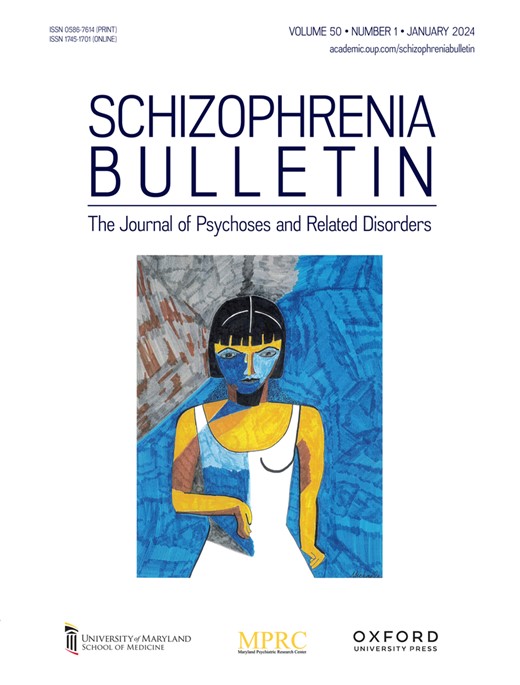Molecular Evidence for Altered Angiogenesis in Neuroinflammation-Associated Schizophrenia and Bipolar Disorder Implicate an Abnormal Midbrain Blood-Brain Barrier
IF 5.3
1区 医学
Q1 PSYCHIATRY
引用次数: 0
Abstract
Background and Hypothesis Angiogenesis triggered by inflammation increases BBB permeability and facilitates macrophage transmigration. In the midbrain, we have discovered molecular alterations related to the blood-brain barrier (BBB), including endothelial cell changes associated with macrophage diapedesis, in neuroinflammatory schizophrenia and bipolar disorder, but changes in angiogenesis are yet to be reported. Hypothesis: We expected to discover molecular evidence of altered angiogenesis in the midbrain in individuals with schizophrenia and bipolar disorder compared to controls, with these changes more evident in “high” inflammation schizophrenia as compared to “low” inflammation. Study Design In a case-control post-mortem cohort including schizophrenia (n = 35), bipolar disorder (n = 35), and controls (n = 33), we measured mRNA (RT-PCR) and protein (multiplex immunoassays) and performed immunohistochemistry to determine levels and anatomical distribution of angiogenesis-related molecules in the ventral midbrain. Study Results We found large changes in angiogenesis factors in bipolar disorder high inflammatory subgroup (increased angiopoietin-2 and SERPINE1 mRNAs, but decreased angiopoietin-1, angiopoietin-2, and TEK receptor proteins). In schizophrenia high inflammatory subgroup, we found a robust increase in SERPINE1 mRNA and protein levels. However, we found no significant changes in angiopoietins in schizophrenia. We found that VEGFA mRNA level was increased in high inflammation schizophrenia, but only reached statistical significance compared to one low inflammatory subgroup. Conclusions Thus, angiogenesis signaling pathways appeared to be involved in the BBB alterations when inflammation is also present in the midbrain of schizophrenia and bipolar disorder, with increased levels of SERPINE1 in schizophrenia high inflammatory subgroup and with a putative suppression of angiopoietin signaling in bipolar disorder high inflammatory subgroup.神经炎症相关精神分裂症和双相情感障碍中血管生成改变的分子证据暗示中脑血脑屏障异常
背景与假设 炎症引发的血管生成增加了血脑屏障的通透性并促进了巨噬细胞的迁移。在中脑中,我们发现了与血脑屏障(BBB)有关的分子改变,包括神经炎症性精神分裂症和躁狂症中与巨噬细胞移行有关的内皮细胞改变,但血管生成的改变尚未见报道。假设:与对照组相比,我们期望发现精神分裂症和双相情感障碍患者中脑血管生成改变的分子证据,与 "低 "炎症相比,这些变化在 "高 "炎症精神分裂症中更为明显。研究设计 在包括精神分裂症(35 人)、躁狂症(35 人)和对照组(33 人)在内的病例对照尸检队列中,我们测定了 mRNA(RT-PCR)和蛋白质(多重免疫测定),并进行了免疫组化,以确定腹侧中脑中血管生成相关分子的水平和解剖分布。研究结果 我们发现双相情感障碍高炎症亚组的血管生成因子发生了很大变化(血管生成素-2和SERPINE1 mRNA增加,但血管生成素-1、血管生成素-2和TEK受体蛋白减少)。在精神分裂症高度炎症亚组中,我们发现 SERPINE1 mRNA 和蛋白质水平均有显著增加。然而,我们发现精神分裂症患者的血管生成素没有明显变化。我们发现,高炎症亚组精神分裂症患者的血管内皮生长因子(VEGFA)mRNA水平升高,但与低炎症亚组相比,仅达到统计学意义。结论 因此,当精神分裂症和双相情感障碍的中脑也存在炎症时,血管生成信号通路似乎参与了 BBB 的改变,精神分裂症高炎症亚组的 SERPINE1 水平升高,而双相情感障碍高炎症亚组的血管生成素信号可能受到抑制。
本文章由计算机程序翻译,如有差异,请以英文原文为准。
求助全文
约1分钟内获得全文
求助全文
来源期刊

Schizophrenia Bulletin
医学-精神病学
CiteScore
11.40
自引率
6.10%
发文量
163
审稿时长
4-8 weeks
期刊介绍:
Schizophrenia Bulletin seeks to review recent developments and empirically based hypotheses regarding the etiology and treatment of schizophrenia. We view the field as broad and deep, and will publish new knowledge ranging from the molecular basis to social and cultural factors. We will give new emphasis to translational reports which simultaneously highlight basic neurobiological mechanisms and clinical manifestations. Some of the Bulletin content is invited as special features or manuscripts organized as a theme by special guest editors. Most pages of the Bulletin are devoted to unsolicited manuscripts of high quality that report original data or where we can provide a special venue for a major study or workshop report. Supplement issues are sometimes provided for manuscripts reporting from a recent conference.
 求助内容:
求助内容: 应助结果提醒方式:
应助结果提醒方式:


